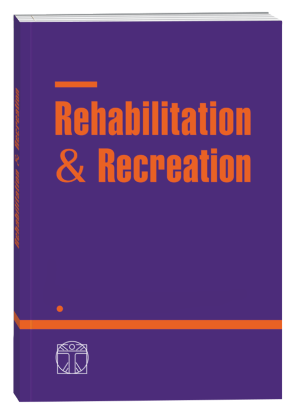REHABILITATION MANAGEMENT IN DISTAL SENSIMOTOR POLYNEUROPATHY OF DIABETIC GENESIS
DOI:
https://doi.org/10.32782/2522-1795.2023.16.6Keywords:
diabetic polyneuropathy, pain syndrome, physical therapy, rehabilitation assistance, examination, effectiveness of intervention.Abstract
Rehabilitation assistance to patients with diabetic polyneuropathy is a difficult multidisciplinary task, and its solution should be complex based on the application of pathogenetically justified medicinal and non-medicinal methods. Regardless of the presence of complications and their degree of severity, the main strategies for the rehabilitation of such patients include: glycemic control, diet therapy, medicinal pathogenetic therapy, physiotherapeutic methods of treatment, physical therapy (kinesiotherapy) and reflexology. The purpose of the study is to develop, scientifically justify and implement the algorithm of the physical therapy program for patients with distal sensorimotor polyneuropathy of diabetic origin. Research methods. The following research methods were used to achieve the goals and objectives of the specified research: at the level of structure / function according to the ICF: clinical examination, which included an assessment of complaints, anamnesis; neuropathy symptom scale (Neurological Symptom Scores, NSS); Neuropathy Disability Score (NDS); NTSS‑9 (Neuropathy Total Symptom Score‑9) scale of symptoms of diabetic distal neuropathy; visual analog pain scale; McGill Pain Questionnaire; manual muscle testing; at the level of activity and participation: questionnaire SF‑36 (Short Form – 36); the “Timed Up and Go test/TUG” test. All patients included in the study underwent clinical and special research methods that meet the standards of research in this pathology and are based on the ICF. The study was conducted on the basis of the Municipal non-profit enterprise “Clinical Hospital of Saint Panteleimon” of the Sumy City Council in the conditions of the department of physical and rehabilitation medicine. The study included 10 patients (7 women and 3 men) with type 2 diabetes mellitus of moderate severity in a state of compensation or subcompensation, complicated by distal sensorimotor diabetic polyneuropathy. Research results. Based on the analysis of theoretical data and materials of own research, an algorithm of the physical therapy program for patients with distal sensorimotor polyneuropathy of diabetic genesis was developed, depending on the severity of the pain syndrome and the severity of the clinical manifestations of diabetic polyneuropathy according to the scale of neurological symptoms of the NSS. The findings identified risk factors for the development of pain syndrome and revealed that the degree of impaired balance and movement in patients with diabetes inversely depends on the severity of neurological symptoms and the intensity of pain syndrome.
References
Козьолкін О.А., Мєдвєдкова С.О., Ревенько А.В. Реабілітація хворих з вибраними неврологічними синдромами : навч. посіб. для самостійної роботи лікарів-інтернів за спеціальністю «Неврологія», «Загальна практика – сімейна медицина», лікарів- неврологів, сімейних лікарів. Запоріжжя : ЗДМУ, 2021. 87 с.
Дубинецька В.М., Чуприна Г.М. Діабетична полінейропатія: погляд на проблему крізь призму коморбідності. Східноєвропейський неврологічний журнал. 2019. Вип. 1(25). С. 37–46.
Ahmad I., Verma S., Noohu M.M., Shareef M.Y., Hussain M.E. Sensorimotor and gait training improves proprioception, nerve function, and muscular activation in patients with diabetic peripheral neuropathy: a randomized control trial. J. Musculoskelet. Neuronal. Interact. 2020. Vol. 20(2). P. 234–248.
Шупер С.В, Шупер В.О., Рикова Ю.О., Темерівська Т.Г., Гусак В.В. Оцінка ефективності та доцільності застосування засобів фізичної терапії у хворих із діабетичною периферійною полінейропатією. Український журнал медицини, біології та спорту. 2020. Вип. 5(27). С. 265–270.
Шупер С.В., Шупер В.О., Будник Л.М., Докаль І.Я., Гусак В.В., Рикова Ю.О. Оцінка ефективності фізичної реабілітації хворих із діабетичною периферичною полінейропатією. Вісник Прикарпатського університету. Серія «Фізична культура». 2019. № 31. С. 165–173.
Свиридова Н.К., Чуприна Г.М., Дубинецька В.М., Тижук З.Л. Фізичне та психічне функціонування осіб з діабетичною полінейропатією на фоні мультиморбідності. East European Journal of Parkinson’s Disease and Movement Disorders. 2020. Vol. 6(3–4). Р. 8–17.
Adelmanesh F. Reliability, validity, and sensitivity measures of expanded and revised version of the short-form McGill Pain Questionnaire (SF-MPQ-2) in patients with neuropathic and non-neuropathic pain. Pain. Med. 2012. Vol. 13(12). P. 1631–1636.
Міжнародна діабетична федерація (IDF). URL: http://www.idf.org/2013.
Gandhi M., Fargo E., Prasad- Reddy L., Mahoney K.M., Isaacs D. Diabetes: how to manage diabetic peripheral neuropathy. Drugs Context. 2022. № 11. Р. 20–21.
Petersen E., Stauss T.G., Scowcroft J.A. Effect of high-frequency (10-khz) spinal cord stimulation in patients with painful diabetic neuropathy. JAMA Neurol. 2021. Vol. 78(6). P. 687–698.
Downloads
Published
How to Cite
Issue
Section
License

This work is licensed under a Creative Commons Attribution-NonCommercial-NoDerivatives 4.0 International License.











